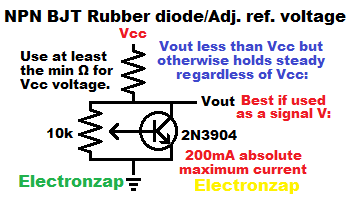Table of Contents
A Bipolar Junction Transistor (BJT) with a voltage divider across its terminals will build up an adjustable amount of voltage across it. Even as supply voltage changes.

Once the potentiometer is set, the transistor will conduct current better as the voltage across it tries to go up.
Whereas the transistor will conduct less current when the voltage across it tries to go down.
So the transistor actively pass current as needed to maintain a voltage across the collector and emitter.
Maximum current needs to be limited by some more resistance on the high side (closer to Vcc) of an NPN BJT.
Video:
To support this site, check out the following links:
- Become a Patron!
- Check out my YouTube videos! https://www.youtube.com/c/Electronzap/videos
- Products I used in my videos or otherwise think look like a good buy. As an Amazon associate, I earn from qualifying purchases. https://www.amazon.com/shop/electronzapdotcom
- Information on this site is not guaranteed to be accurate. Always consult the manufacturer info/datasheet of parts you use. Research the proper safety precautions for everything you do.
- Electronzap is a participant in the Amazon Services LLC Associates Program, an affiliate advertising program designed to provide a means for sites to earn advertising fees by advertising and linking to amazon.com.